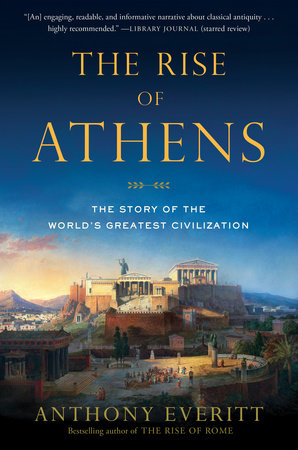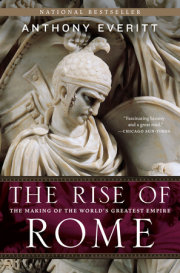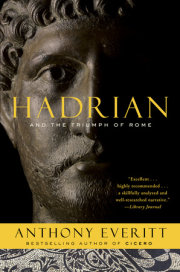1
National Hero
The geography of their homeland helped mold the collective character of the ancient Athenians and of all the other sporadic communities that shared the Greek peninsula. Rocky, bare mountains are interspersed with numerous, small, fertile plains. But much of the soil is dry and stony, and more suitable for olive trees than fields of wheat. Travel by land between the meager centers of habitation was laborious.
Athens was the chief city of Attica, a triangular tract of level ground about nine hundred square miles in extent. This plain is punctuated by hills and surrounded by mountains on two sides and on a third by the sea. Mount Hymettus was famous for its honey, and still is, and Pentelicon for its honey-colored marble, from which it built its temples to the gods. Rich lead and silver deposits at Laurium in the southeast were found and mined. Summers are hot and dry and heavy outbursts of rain mark the fall.
The poverty of the land of Greece brought with it three consequences. It bred a fierce individualism, a cantankerous refusal to agree with those living on the other side of mountains; states were many and tiny and Athens was one of the largest. Unable to feed their growing numbers, the Athenians became seafarers, although sailing was dangerous in the windy winters. Around the eighth century they joined other Greek statelets in exporting surplus citizens to new settlements around the Mediterranean littoral and importing grain from the Black Sea and elsewhere in growing quantities.
The citadel of Athens was the Acropolis, or “high city,” an almost impregnable outcrop that rises one hundred and fifty meters above sea level. There is evidence of human occupation as early as 5,000 b.c., but we hear little of the place during the age of the Mycenaean monarchs.
The Athenians held that they belonged to an ethnic group called the Ionians, who had always lived in Greece (the word derives from Ion, a semi-legendary king of Athens). Not long after the traditional date of the fall of Troy towards the end of the second millennium, another group called the Dorians, Greek speakers but with their own cultural customs and dialect, came down from the north and settled in Greece. Under pressure from these newcomers, some Ionians emigrated to Asia Minor where they settled and prospered. Athens argued that she was “the eldest land of Ionia” and felt some ongoing responsibility for her cousins overseas.
How many of these beliefs are true cannot now be told and we have no choice but to open our narrative with instructive fiction rather than irretrievable fact.
The future of Athens was determined by a goddess, Pallas Athena, and by a king called Theseus, whose legendary character traits express, for good or ill, Athenian identity.
It was as well not to cross Athena’s path. From the moment of her birth she emanated power. Her father, Zeus, had sex with Metis, the divine personification of Wisdom, but then had second thoughts. Fearing that their child would grow up to be more intelligent than he was himself, he opened his mouth wide and swallowed Metis up. Nine months later he experienced a raging—literally, it would turn out, a splitting—migraine. He ordered his son Hephaestus, god of metalwork, to strike his head with an ax, hoping that this would relieve the pain. The divine blacksmith obeyed and out jumped Athena from the crack in his skull, adult and fully armed.
She was a perpetual virgin and tomboy. As goddess of war, she could vanquish in combat her half brother Ares (the Roman Mars), lord of battles who delighted in the slaughter of men and the sack of towns. However, Athena took no pleasure in fighting and preferred to settle disputes by discussion and mediation. She patronized crafts and the making of clothes.
She is unique among the Olympians in having a city named after her. She regarded Athens as hers following a quarrel with the sea god and brother of Zeus, Poseidon. As a mark of possession, he thrust his trident into the Acropolis and a spring of seawater sprang out from the rock (it still flows today). Later, Athena laid her own claim in a more peaceful manner, by planting the first olive tree alongside the spring. A furious Poseidon challenged her to a duel, but Zeus insisted on peaceful arbitration. A court of Olympian gods awarded the prize to Athena. Poseidon resentfully sent a tsunami to flood Attica, so she took up residence in the city and kept it under watchful guard.
From early times the Athenians welcomed the goddess with open arms. She was foster mother to one of the first kings, the semi-divine Erechtheus. From his vantage point in the eighth century, Homer celebrated
the Athenians from their splendid citadel in the realm of the magnanimous Erechtheus, a child of the fruitful Earth who was brought up by Athena Daughter of Zeus and established by her in her own rich shrine, where bulls and rams are offered to him yearly in due season by Athenian youths.
The Athenians learned from their tutelary goddess that military force was an invaluable arm of policy, but that it should be tempered by metis, wisdom or, in its less complete sense, ingenuity and craftiness.
Aegeus, legendary king of Athens during the Mycenaean age, was childless, but on his travels he enjoyed a one-night stand with an attractive princess. He suspected, or perhaps just hoped, that he had made her pregnant, so he hid a sword and a pair of sandals under a rock. Before leaving, he told the woman that if she gave birth to a son she should show him where they were when he grew up, and tell him to take them with him to Athens.
A baby duly arrived, whom she named Theseus. When a young adult he learned about the tokens from his mother, who gave him Aegeus’s message. He did as he was told and lifted up the rock with ease. He refused to take ship to Athens, although it was the safest method of travel. Instead, looking for adventure, he set off by land to Athens. En route he sought out and destroyed a number of dangerous opponents. The first of them wielded a large club, which Theseus carried about with him ever afterwards, rather as Heracles, whom he greatly admired, invariably wore the skin of a lion he had killed. Next came Sinis the Pine-bender, who tied travelers to two pines he had bent down to the ground; he then let them go, tearing the victims apart.
Feeling randy, Theseus chased after Sinis’s pretty little daughter, who had very sensibly run away. Plutarch reports that he
looked for her high and low, but she had disappeared into a place which was overgrown with shrubs and rushes and wild asparagus. The girl in her childish innocence was imploring the plants to hide her; and promising that if they saved her, she would never trample them down or burn them. Theseus called her and gave her his word that he would not harm her but treat her with respect—and she came out.
Once he had caught her, he took her to his bed. After she had borne him a son, he married her off to some nonentity. Throughout his life Theseus was a sexual predator.
After this diversion he resumed his Heraclean labors. Next on his list was the terrifying Crommyonian sow; some said she was not a pig but a depraved murderess who was “nicknamed the Sow because of her life and habits.” Either way, Theseus killed her. He then dispatched the robber Sciron. His modus operandi had been to stick out his feet to passersby on a narrow cliff path and to insist they wash them. While they were doing so he tipped them into the sea. Of other challengers the most alarming was Procrustes, who forced travelers to fit onto his iron bed; if they were too tall he cut off their legs and if too short stretched them as on a rack until they were the right size.
At long last Theseus made it to Athens. He was unknown to anyone there. His tunic was unusually long and touched his feet. His hair was plaited and, according to an ancient commentator, “nice-looking.” He passed a temple construction site and the builders jeered at him. What, they bantered, was a marriageable girl doing wandering about on her own? Theseus said nothing, but took the oxen from the men’s cart and flung them over the temple’s half-built roof. He was not a man to suffer fools gladly.
Strangers in ancient Greece were routinely given a hospitable welcome and the king offered Theseus a meal in his palace on the Acropolis. His wife, the celebrated witch Medea—back from the Black Sea with the Argonauts—knew who Theseus was. Fearful that her position would be threatened by the arrival of a son, she persuaded the aged and infirm Aegeus to have this potentially troublesome foreign guest poisoned at dinner.
For his part the young man thought it best to reveal his identity to his father tactfully; when the meat was served he drew his sword as if to cut off a piece, hoping that the king would recognize it. Aegeus saw the weapon and immediately acknowledged his son’s identity. We may assume that the food was removed. After beating off some competitors for the succession to the throne, Theseus became heir apparent. Medea left town.
Not long afterwards collectors of human tribute arrived from Crete. Largest of the Greek islands, it was the center of a great maritime civilization that flourished from about 2,700 to the fifteenth century. Modern archaeologists have called it Minoan after the mythical king of Crete, Minos.
His son died a mysterious but violent death while on a visit to Athens, possibly at the hands of Aegeus. Minos was enraged with grief. He fought and won a war of revenge against Athens and in compensation for his loss demanded the handover every nine years of seven young men and seven young women, chosen by lot. They were sent to Crete and imprisoned in a labyrinth where a monster half man and half bull lived, called the Minotaur. He was the product of an extramarital liaison between Minos’s wife, Pasiphae, and a white bull with whom she had become infatuated. He killed all the captives.
Athenian public opinion was highly critical of Theseus. Here was the heir to the throne, a bastard and a foreigner, coming off scot-free, while ordinary people’s legitimate children were being sent to a dreadful fate. Theseus took the point and volunteered to be a member of the tribute group and destroy the Minotaur.
Being of a tricky frame of mind, he swapped two of the girls for a couple of pretty (but manly) boys; he softened their skins by warm baths, kept them out of the sun, got them to use makeup, gave them frocks, and trained them to walk in a feminine manner (we shall see later that this was not the only time a Greek used drag as a deadly ruse).
On previous occasions the ship carrying the captives had shown a black sail, as a sign of mourning. But Theseus promised that he would give the captain another sail, a white one, for him to hoist on the return voyage as a sign that he had killed the Minotaur.
Minos’s daughter Ariadne fell in love with Theseus and showed him how to master the intricacies of the labyrinth. She gave him a ball of string, which he unwound as he walked along, thus enabling him to find his way back. As he had vowed, he put the Minotaur to death and cut off its head.
Theseus and the other boys and girls escaped from Crete. The now pregnant Ariadne and her sister came along with them, but they were dumped on the island of Naxos. Ariadne hanged herself in despair (or, according to another account, married on the rebound the wine god Dionysus, who was passing by).
As they approached Attica, Theseus and the ship’s captain forgot to change the sails. When Aegeus saw the boat come into harbor sporting its black flag, he committed suicide by flinging himself off the Acropolis.
As we have seen, Theseus had a cheating, sometimes violent way with women. He and his best friend, a Thessalian called Pirithous, kidnapped Helen, later to be “of Troy.” He was fifty years old and she a prepubescent girl; he said he meant to keep her until she was old enough to marry and have sex with. But she was rescued and the plan failed.
Theseus joined in a war with the Amazons, a race of aggressive women who forswore men. Their queen, Hippolyta, was tricked into boarding Theseus’s ship; he took her back to Athens where he married her. However, he soon put her away in favor of Ariadne’s little sister, Phaedra.
Pirithous had the not-so-clever idea of going down into the underworld and kidnapping the Queen of the Dead, Persephone. He took Theseus along with him and the pair wandered around the outskirts of Tartarus, a deep abyss where the wicked are endlessly tortured. They were caught and led away to eternal punishment by the Furies, ancient goddesses of vengeance, who had snakes in their hair and whips in their hands. Both men were placed on the Chair of Amnesia; they grew into it and were held fast by coiled serpents. Here they were to live or partly live forever.
By a stroke of luck Heracles happened to be visiting. He was engaged on the last of his Labors, the capture of Cerberus, the three-headed dog that guarded the entrance to the underworld. He persuaded Persephone to let bygones be bygones and Theseus was restored to the upper air. His comrade remained unforgiven and, for all we know, is still suffering.
On his return to Athens, the family atmosphere in the palace on the Acropolis became strained when Phaedra fell incestuously in love with Hippolytus, Theseus’s son by Hippolyta. He rejected her advances. False evidence from Phaedra led the angry king to cause his son’s death at the hands of the sea god Poseidon. She then killed herself out of guilt.
The Athenians were sure that Theseus was a historical figure. A thirty-oared galley, said to be the ship on which he had sailed to and from Crete, was preserved and was still on public display in the fourth century. Its old timbers were replaced with new wood as they rotted away. This gave philosophers a handy conundrum for their pupils. When all the timbers had been exchanged, was the ship the same ship or a different one?
Copyright © 2016 by Anthony Everitt. All rights reserved. No part of this excerpt may be reproduced or reprinted without permission in writing from the publisher.










